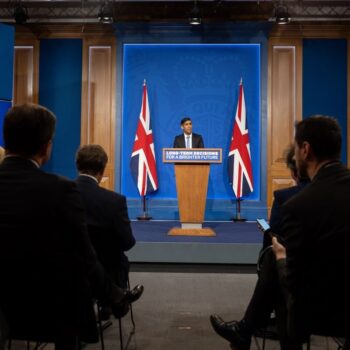Research released today reveals that the UK has the sixth-worst long-term rate of excess winter mortality out of 30 European countries [1]. In addition, when taking into account cold weather beyond just the winter months, the UK ranks second-worst out of 30 European countries [2].
Over the last five years there has been an average of 32,000 excess winter deaths in the UK every year. Of these, 9,700 die due to a cold home [3] – the same as the number of people who die from breast or prostate cancer each year. The fact that UK homes are amongst the least energy efficient in Europe [4] confirms that these deaths are preventable.
The new analysis by independent climate think tank E3G [5] and National Energy Action (NEA) [6], the UK’s leading fuel poverty organisation, is released on Fuel Poverty Awareness Day [7], the national day highlighting the problems faced by those struggling to keep warm in their homes.
Pedro Guertler, co-author of the report from E3G comments:
The UK has one of the worst records on cold homes-related deaths in Europe and it is not only a public health tragedy, it is a national embarrassment. This epidemic is entirely preventable and E3G and NEA are calling on the UK Government to reinstate public capital investment in home energy efficiency to fix the cold homes crisis. As well as ending needless suffering and premature deaths, it would also address a wide range of national infrastructure priorities.
Alongside existing private investment, E3G and NEA are calling on the Treasury to use public infrastructure capital – as opposed to revenue expenditure – to co-fund area- based energy efficiency schemes to systematically improve the quality of UK housing in every part of the country [8]. The report says this is essential if the UK is to meet its fuel poverty and carbon emission reduction targets. Scotland, Wales and Northern Ireland have already been developing these programmes with great success but the UK Government has yet to back similar programmes in England and the number of insulation measures installed in UK homes has crashed by 90% since 2012 [9] due to ill-judged cuts to home energy improvement programmes.
Peter Smith, the co-author from NEA adds:
As the UK experiences one of the harshest winters for several years, it is important to remember that this causes needless hardship, places health at risk and leads to premature death. Beyond the terrible scale of cold related winter deaths, people experiencing fuel poverty can also struggle with poor mental health and this can sadly lead to total social isolation and even suicide. This preventable tragedy must end. The UK Government must support the strong case for the re-introduction of adequate public capital investment – a necessity if we are to make the UK’s homes warmer and safe for human habitation.
The warning comes on NEA’s Fuel Poverty Awareness Day (taking place on 23 February). The day of awareness follows NEA’s warning late last year that low income families have little to no financial safety net and the gap between their incomes and what they need to spend to meet the essential cost of living can be as much as £9,000 [10].
ENDS
Available for comment
For further information on the detail of this release contact Peter Smith and Ed Matthew or call 07867 314004 or 07595 780893.
Notes to Editors
[1] See Table 1, taken from: Liddell, C., Morris, C., Thomson, H. & Guiney, C. (2016) Excess winter deaths in 30 European countries 1980–2013: a critical review of methods. Journal of Public Health. [Online] 38 (4), 806–814. Available from: doi:10.1093/pubmed/fdv184Table 1: Excess winter mortality index for 30 European countries, 1980-2013

Table 2: Ranking of 30 European countries’ ratio of EWM index to IHDD (Liddell et al., 2016)

Table 3, taken from report. Living in the poorest quality housing causes places health at risk and leads to premature death. In 2016/17 there were 37,020 excess winter deaths in the UK, the second highest number in five years. 11,110 of these deaths were attributable to cold homes. Ill health caused by poor housing is an even bigger problem. Treating the health impacts of cold homes, including cardiovascular and respiratory diseases, falls and injuries and mental ill health, is costing the NHS an estimated £1.36 billion each year.
Table 3: Excess winter deaths considered attributable to cold housing conditions

- Guertler, P., Carrington, J. & Jansz, A. (2015) The Cold Man of Europe – 2015.
- Guertler, P. & Royston, S. (2013) Fact-file: The Cold Man of Europe.
The Warm Homes and Energy Conservation Act 2000 states that a person is to be regarded as living "in fuel poverty" if they are a member of a household, living on a low income, in a home which cannot be kept warm at reasonable cost. Since 2011, fuel poverty in England is defined using the Low Income High Cost (LIHC) definition to measure progress. This states that an individual is considered fuel poor where they have fuel costs that are above average (the national median level) and, were they to spend that amount they would be left with an income below the poverty line. Progress to monitor fuel poverty across the other three UK nations is still measured using the previous 10% definition and effects 4 million UK households. In England, where public investment has been cut hardest, fuel poverty affects around 2.50 million households, representing approximately 11 % of all English households compared to 2.38 million households (or 10.6% of all households) in England in 2014. This too was a small increase from 2.35 million households in 2013 – the level of fuel poverty prior to the fuel poverty strategy being passed in Parliament. The fuel poverty gap – an estimation of the additional amount that those in fuel poverty need to pay to heat their homes adequately compared to average households – has not shown any real progress either and remains at around £884 million. The most acute levels of fuel poverty are in the Private Rented Sector.
[8] E3G and National Energy Action are members of the Energy Efficiency Infrastructure Group (EEIG), which commissioned a milestone report [Affordable Warmth, Clean Growth – Action Plan for a Comprehensive Buildings Energy Infrastructure Programme ] setting out a vision for a Buildings Energy Infrastructure Programme, prioritising cold homes and low income households on the path for all homes to achieve the EPC C standard by 2035. The vision includes the goal for all low income households’ homes in the UK to be upgraded to an EPC C standard by 2030. To achieve this, it recommends funding a coordinated programme of locally-led, area- based schemes supporting low income households with home energy performance improvements in every local authority area – alongside a UK-wide referrals network to nationally available ‘safety net’ grant support for households who miss out on, or cannot wait for, area-based schemes to reach them. This combination of area schemes and safety net has been the hallmark of energy efficiency delivery for low income households in the devolved nations of Northern Ireland, Scotland and Wales in recent years.Late last year, E3G and NEA welcomed the UK Government’s Clean Growth Strategy and the National Infrastructure Commission’s (NIC) interim National Infrastructure Assessment. The Clean Growth Strategy includes a target to get all homes to achieve the EPC C standard by 2035 and recommits to meeting existing fuel poverty statutory targets. The National Infrastructure Commission’s (NIC) interim National Infrastructure Assessment (NIA) also states the importance of energy efficiency and stated that an urgent priority was to address the energy wastage in UK homes and said energy efficiency must be a key national infrastructure priority. Despite these welcome reports, the UK Government has failed to set out the details of any new energy efficiency programmes and the number of insulation measures installed in UK homes has crashed by 90% since 2012. The numbers of boilers installed/replaced over a three-month period has also crashed from a high of 85,000 in 2013 to a new low of 7,000 between April and July last year.
[9] See: Committee on Climate Change (2018) An independent assessment of the UK’s Clean Growth Strategy – From ambition to action. [10] See: NEA (2017) Bridging the Gap: Addressing the cost of living facing UK households this winter.

